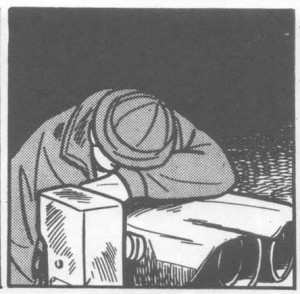This is a comment Bill left on an article by Ng Suat Tong.
_________________________
I’ll add that Tatsumi’s story in English is about marketing and a lack of context. D&Q has marketed Tatsumi and “gekiga” very well, though it’s worth noting that the term “gekiga” first appeared in issue 12 (1957) of “Machi,” a rental manga, as a blurb on a Tatsumi title page: “GHOST TAXI” has the title, “Mystery Gekiga” (Encyclopedia of Contemporary Manga, p. 62). It feels closer to “Ghost Taxi Mystery Theater” to me than, say, an equal of any of Kurosawa’s gendai-geki or jidai-geki from the period. Decades later, the gekiga “brand” and an unimpressive body of work have Dwight Garner in the NYTimes saying of Tatsumi’s work, “It’s among this genre’s signal achievements.” (At least Gary Groth, to his credit, never bought it: “I usually only interview artists whose work I like, and I didn’t feel entirely comfortable interviewing Tatsumi. I was troubled by a number of tics that comprised the backbone of Tatsumi’s aesthetic…” TCJ #281, p. 37)
I wanted to add a footnote from a couple Japanese sources: The Encyclopedia of Contemporary Manga, 1945-2005 (Shougakukan), ends its sole entry on Tatsumi with with the fairly tepid, “Recently, his esteem has also grown abroad.” (Just before its publication, in 2003 AX #34 presented an unpublished Tatsumi story with a full-page ad proclaiming his work would be published in the West. AX is from Seirinkogeisha, now the Japanese publisher of his work as well as others in that tradition.)
The rest of the encyclopedia’s entry was a plot summary of the short story “Man-Eating Fish” and a sentence noting how Tatsumi “deeply expressed the dead-end circumstances of men living in society’s lower reaches” (clunky offhand translations mine). A true documentary of those men would be more interesting, but he prefers tidy immorality plays. Even his images, some fine examples of which you selected, no more than equal those of his peers. It’s telling that another Japanese work, the critic Natsume Fusanosuke’s formalist critique “Why Is Manga Interesting,” chooses artists like Nagashima, Tsuge, and Sait? in describing the old gekiga style, but not Tatsumi. Would that D&Q had published five volumes of Shigeru Mizuki and a slim one of Tatsumi. The rest of their gekiga line’s quite strong, but the word’s not very helpful, and the brand even less if it means Tatsumi’s the touchstone for excellent artists like Ouji, Sakabashira, and Mizuki. Mizuki’s a giant; Tatsumi was forgotten until D&Q picked him back up. The result has been a distorted image of his work’s importance more than a valid reassessment, one that even the New York Times repeated uncritically.

